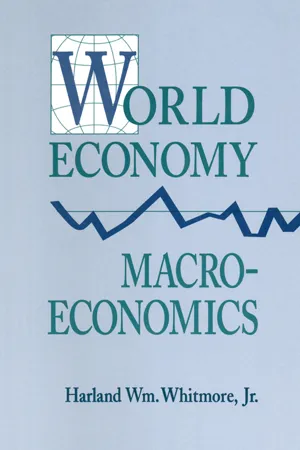
This is a test
- 272 pages
- English
- ePUB (mobile friendly)
- Available on iOS & Android
eBook - ePub
World Economy Macroeconomics
Book details
Book preview
Table of contents
Citations
About This Book
This text develops a complex open economy macro-model of the world economy that synthesizes the new Keynesian and new classical approaches to constructing aggregate models. It extends the two approaches by offering a more general international and intertemporal transmission mechanism.
Frequently asked questions
At the moment all of our mobile-responsive ePub books are available to download via the app. Most of our PDFs are also available to download and we're working on making the final remaining ones downloadable now. Learn more here.
Both plans give you full access to the library and all of Perlego’s features. The only differences are the price and subscription period: With the annual plan you’ll save around 30% compared to 12 months on the monthly plan.
We are an online textbook subscription service, where you can get access to an entire online library for less than the price of a single book per month. With over 1 million books across 1000+ topics, we’ve got you covered! Learn more here.
Look out for the read-aloud symbol on your next book to see if you can listen to it. The read-aloud tool reads text aloud for you, highlighting the text as it is being read. You can pause it, speed it up and slow it down. Learn more here.
Yes, you can access World Economy Macroeconomics by Harland William Whitmore in PDF and/or ePUB format, as well as other popular books in Business & Business General. We have over one million books available in our catalogue for you to explore.
Part I
CHAPTER ONE
Introduction
Today, more than ever, international trade and finance inextricably link together the economies of individual nations. This is particularly true for large open economies and free-trade associations, such as those found in North America, Europe and the Pacific Rim. More than ever, in order to understand how large open economies operate, we must analyze them within the context of the broader world economy.
In this book we present a general dynamic two-country model of the world economy. Each country is large and produces a single good, which is assumed to be an imperfect substitute for the good produced in the other country. In each country wages and product prices are set at the beginning of each period by an optimizing nonfinancial business sector. The markets for goods and labor do not necessarily clear. The model presented here not only synthesizes the New Keynesian and New Classical approaches to constructing macroeconomic models, but also extends the international and intertemporal linkages beyond those contained in either approach.
We synthesize the two approaches by offering a mutually consistent set of first principles for every sector’s decision in every market, in a manner consistent with both the New Keynesian and New Classical approaches. Intertemporal budget constraints similar to the ones employed by Frenkel and Razin [1992] tie the production, spending and saving decisions of each sector directly to their respective end-of-period stocks of assets and liabilities.1 Consequently, the stocks of real and financial assets vary endoge-nously over time along with production, spending, employment, wages, prices, interest rates and exchange rates.
In addition, we view current output as invariant with respect to current aggregate demand, in a manner consistent with the New Classical approach.2 In particular, the nonfinancial business sectors in both countries set wages and product prices and decide current output before current aggregate demand is revealed; current aggregate demand in each country is jointly determined later during the current period along with current interest rates and exchange rates.3 Viewing wages and product prices as set at the beginning of each period by present-value maximizing imperfect competitors in the product and labor markets is consistent with the New Keynesian approach in that it allows for the existence of both involuntary unemployment and unanticipated inventory accumulation.4
Even though current output is independent of current aggregate demand, current aggregate demand does influence (future) production both at home and abroad, in a manner (somewhat) consistent with the New Keynesian (or income-expenditure) approach.5 Specifically, since current aggregate demand is jointly determined with current interest rates and current exchange rates and since these variables affect the relative prices at which the nonfinancial business sectors can acquire certain factors of production during the current period to be used in future production, current aggregate demand plays an integral role in determining the costs of producing goods next period in both countries. Also, current aggregate demand directly affects the end-of-period inventories held by the nonfinancial business sectors, which in turn affect not only their marginal costs of supplying goods next period, but also possibly their subsequent forecasts of aggregate demand.
The present model extends the analysis of both the standard income expenditure and New Classical approaches by considering a wider range of financial markets than contained in existing models. The present two-country model contains both a spot market and a forward market for foreign exchange, markets for checkable deposits issued by the two private financial sectors, and two bond markets. Taken together, these markets simultaneously constitute markets for home and foreign currency. The bonds issued in one country are imperfect substitutes for those issued in the other country. The spot market exists so that participants may purchase bonds issued by the o...
Table of contents
- Cover
- Half Title
- Title Page
- Copyright Page
- Dedication
- Table of Contents
- Acknowledgments
- List of Figures
- Part I
- Part II
- Part III
- Part IV
- Bibliography
- Index
- About the Author